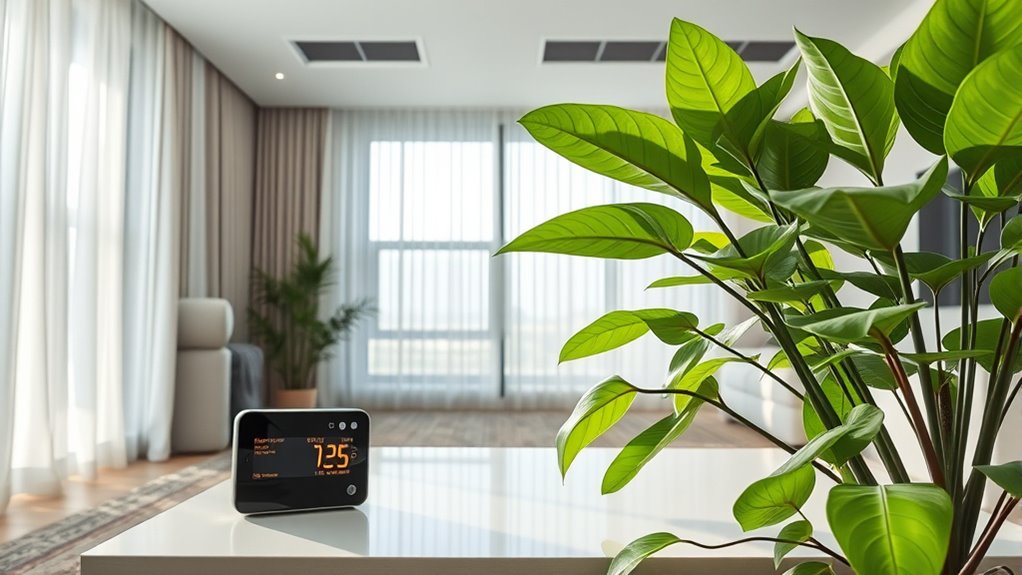To measure and improve indoor air quality, use tools like air quality monitors, particle counters, and humidity sensors to identify pollutants such as VOCs, dust, and CO₂. Maintain proper ventilation by opening windows, using exhaust fans, and optimizing HVAC systems. Incorporate air purifiers with HEPA and activated carbon filters for added purification. Keep humidity levels balanced and address pollution sources promptly. Keep exploring to discover more effective ways to create a cleaner, healthier indoor environment.
Key Takeaways
- Use air quality monitors to measure pollutants like VOCs, particulate matter, CO₂, humidity, and temperature in real-time.
- Regularly calibrate measurement devices and analyze data to identify pollution sources and assess safety levels.
- Improve IAQ by increasing ventilation through windows, exhaust fans, and mechanical systems, and maintaining proper airflow.
- Employ air purifiers with HEPA and activated carbon filters to remove dust, allergens, odors, and VOCs effectively.
- Maintain humidity levels between 30-50%, schedule HVAC maintenance, and minimize indoor pollution sources for long-term air quality management.
Understanding Indoor Air Quality and Its Importance
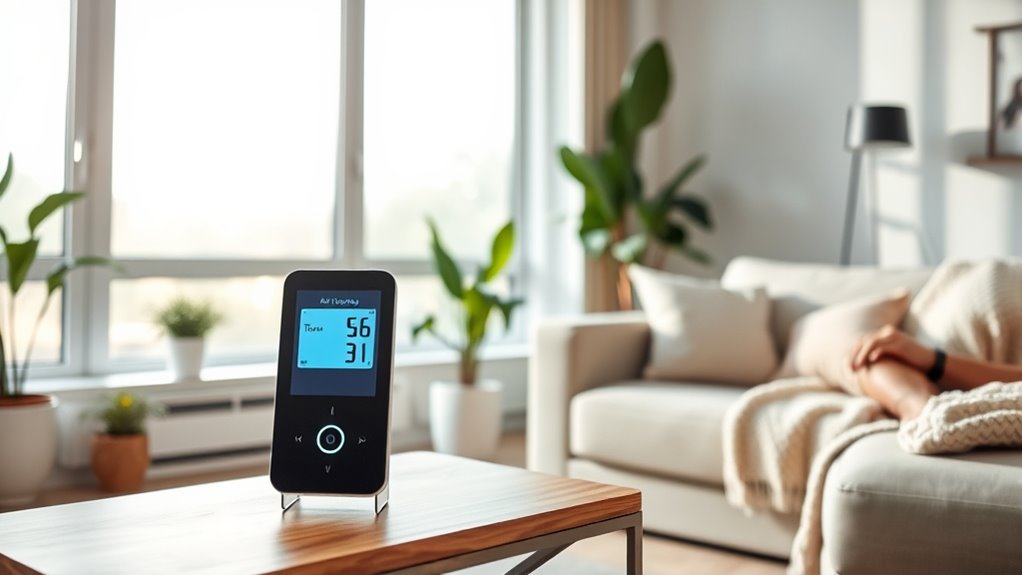
Indoor air quality (IAQ) refers to the condition of the air inside your home or workplace and how it affects your health and comfort. Good IAQ means the air is clean, clear of pollutants, and provides a healthy environment for you and your family. Poor IAQ can lead to health issues like allergies, asthma, and respiratory problems, and can also cause fatigue and headaches. Understanding IAQ helps you recognize its importance and take steps to improve it. Factors such as ventilation, humidity, and cleanliness directly influence the air you breathe daily. By paying attention to IAQ, you can create a safer, more comfortable space that supports your overall well-being and prevents illness caused by indoor pollutants. Recent advances in AI-driven solutions are also helping to monitor and improve indoor air quality more effectively.
Common Sources of Indoor Air Pollution
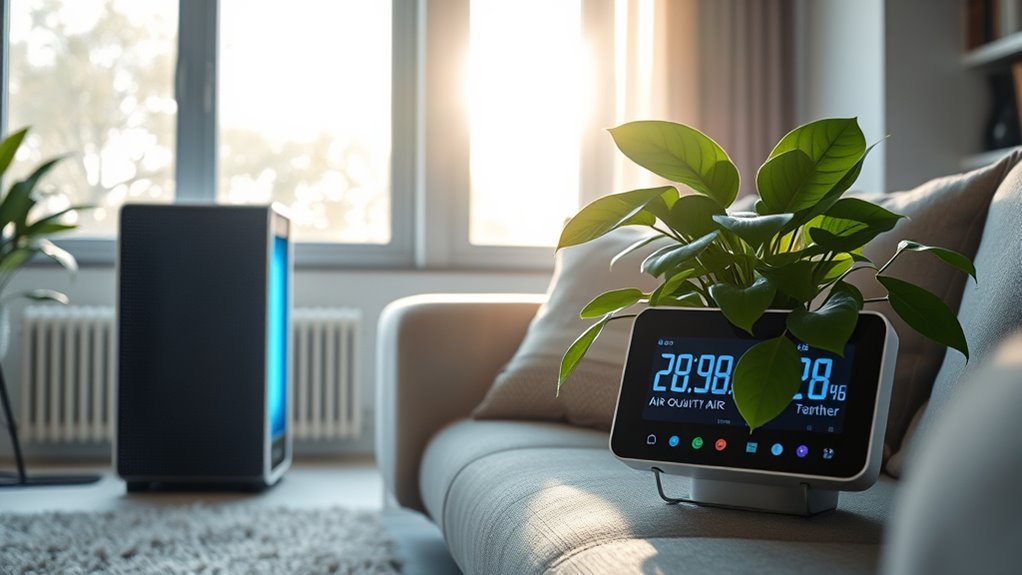
Many everyday activities and household items can introduce pollutants into your indoor environment. Cooking releases airborne particles and gases from fats, oils, and spices, especially if ventilation is limited. Smoking indoors adds a significant amount of harmful chemicals and particulates to the air. Cleaning products often contain volatile organic compounds (VOCs) that can irritate your respiratory system. Carpets, upholstery, and curtains can trap dust, pet dander, and mold spores, which become airborne when disturbed. Heating and cooling systems may circulate allergens or pollutants if not properly maintained. Building materials like paints, varnishes, and adhesives emit VOCs over time. Pet dander and hair are common sources of allergens, while indoor mold growth from excess moisture worsens air quality. Being aware of these sources helps you take control of your indoor environment. Additionally, air quality management services can help identify and mitigate these pollution sources effectively.
Tools and Devices for Measuring Air Quality

To effectively assess air quality in your home, you can use a variety of tools and devices designed to detect pollutants and airborne contaminants. These tools help you identify issues so you can take action. Here are four essential devices:
- Air Quality Monitors – Measure levels of pollutants like VOCs, particulate matter, and CO2 in real-time.
- Particle Counters – Detect and count airborne particles such as dust, allergens, and smoke.
- CO Detectors – Alert you to dangerous carbon monoxide levels that can be invisible and odorless.
- Humidity and Temperature Sensors – Track environmental conditions influencing air quality and mold growth. Proper calibration ensures accurate readings and reliable data from these devices.
Using these devices provides critical insights into your home’s air, enabling you to make informed improvements.
Interpreting Indoor Air Quality Results

When you review indoor air quality results, understanding key metrics helps you determine if your air is safe. Recognizing common pollutants like dust, mold, and volatile organic compounds allows you to identify potential issues. Accurate interpretation guarantees you take the right steps to improve your indoor environment effectively. Being aware of pollutant sources can help you implement targeted solutions to enhance air quality.
Understanding Air Quality Metrics
Understanding air quality metrics is essential for accurately evaluating the indoor environment. To interpret results effectively, you need to know what each metric indicates. First, look at Particulate Matter (PM) levels to gauge airborne dust and allergens. Second, monitor Carbon Dioxide (CO₂) levels, which reflect ventilation efficiency. Third, check Volatile Organic Compounds (VOCs) to identify chemical pollutants from household products. Finally, consider humidity and temperature, as they influence air quality and comfort. Recognizing these metrics helps you identify issues and prioritize improvements. Proper interpretation guarantees you don’t just get numbers but understand what they mean for your health and comfort. This knowledge empowers you to make informed decisions about ventilation, cleaning, and air purification strategies. Incorporating field recording techniques can also help identify specific environmental sounds affecting indoor air quality.
Typical Indoor Pollutants
Indoor pollutants are the substances that can harm your health and reduce air quality, and they come from various sources inside your home. Common pollutants include particulate matter like dust, pet dander, and pollen, which can trigger allergies or asthma. Volatile organic compounds (VOCs) from cleaning products, paints, and furniture release gases that may cause headaches or respiratory issues. Smoke from tobacco or cooking adds harmful chemicals and fine particles to the air. Mold spores from damp areas can worsen allergies and asthma symptoms. Additionally, radon—a naturally occurring radioactive gas—can seep into basements, increasing long-term health risks. Being aware of these typical indoor pollutants helps you identify potential sources and take steps to minimize exposure, creating a healthier indoor environment. Understanding pollutant sources is crucial for implementing effective air purification strategies.
Interpreting Results Accurately
Interpreting indoor air quality results requires careful attention to the data collected from various sensors and testing methods. To make sense of this information, you need to understand what the numbers mean and how they relate to health standards. Here are four key steps:
- Compare results to established indoor air quality guidelines.
- Identify patterns or spikes indicating specific pollutant sources.
- Consider environmental factors like ventilation and occupancy.
- Recognize limitations of your testing methods and equipment.
- Be aware of how air quality tuning can optimize ventilation systems for better indoor environments.
Simple Steps to Improve Indoor Air Quality
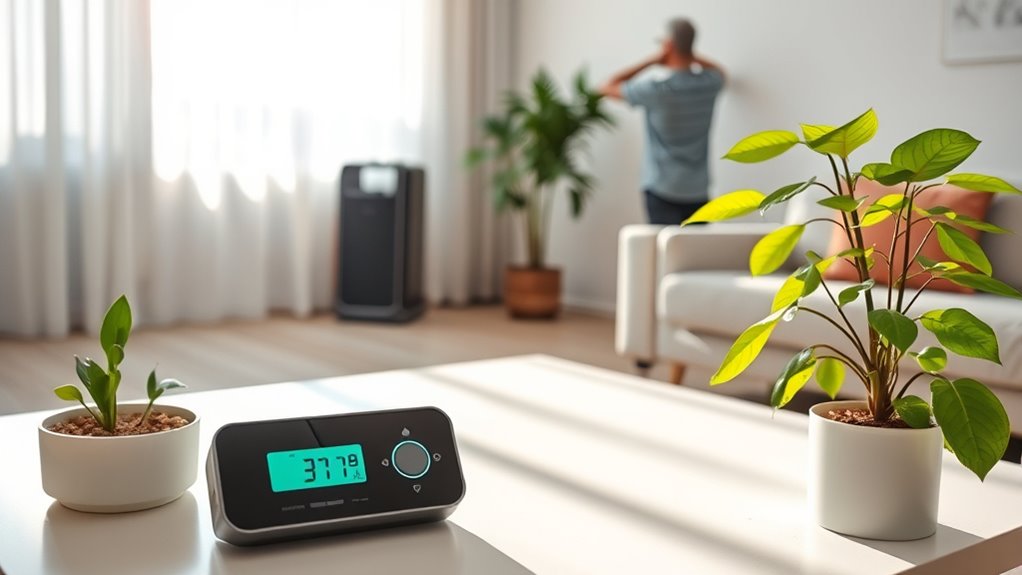
Improving indoor air quality doesn’t have to be complicated; simple steps can make a noticeable difference. Start by keeping your home clean. Regularly dust and vacuum to reduce dust, pet dander, and allergens. Use doormats and encourage handwashing to limit dirt tracked inside. Control humidity levels between 30-50% to prevent mold growth and dust mites. Avoid smoking indoors, as tobacco smoke worsens air quality. Keep windows open when possible to allow fresh air in, especially during cleaning or cooking. Minimize the use of strong chemicals, aerosols, and air fresheners that can release pollutants. Choose natural cleaning products and store chemicals safely. Monitoring indoor air quality can help identify specific pollutants and guide further improvements. These small changes can substantially improve the air you breathe daily, creating a healthier living environment for you and your family.
The Role of Ventilation and Air Exchange
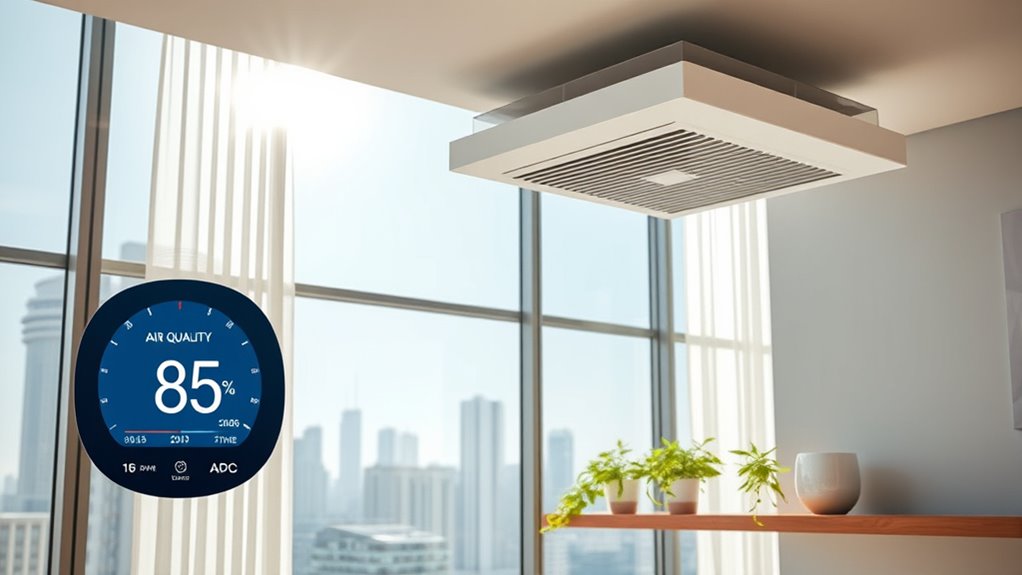
Ventilation and air exchange play a crucial role in maintaining healthy indoor air quality by removing pollutants and bringing in fresh air. Proper ventilation reduces indoor contaminants like dust, allergens, and volatile organic compounds, preventing them from accumulating. It also helps regulate humidity, reducing mold growth. To optimize airflow, consider these strategies:
- Increase natural ventilation by opening windows regularly.
- Use exhaust fans in kitchens and bathrooms to vent moisture and odors.
- Ensure HVAC systems are properly maintained and operated efficiently.
- Incorporate cross-ventilation by opening windows on opposite sides of your space.
Using Air Purifiers and Filtration Systems
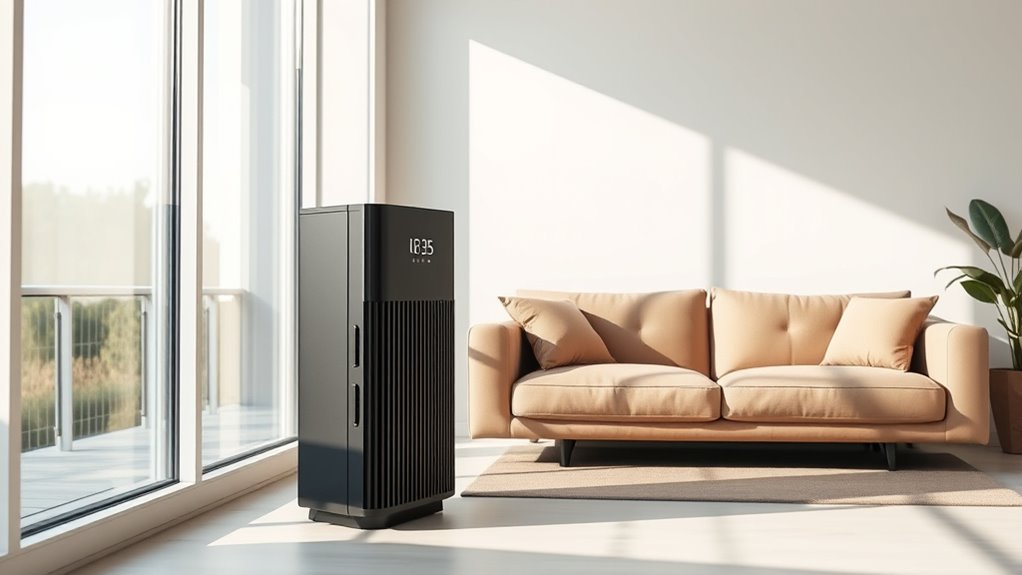
Using air purifiers and filtration systems can substantially enhance indoor air quality by actively removing pollutants from the air you breathe. Air purifiers with HEPA filters capture airborne particles like dust, pollen, pet dander, and mold spores, reducing allergens and irritants. Some models also include activated carbon filters that absorb odors, fumes, and volatile organic compounds (VOCs). When selecting a unit, consider the room size to ensure it’s effective; larger spaces require higher-capacity purifiers. Make sure to replace filters regularly according to manufacturer instructions to maintain peak performance. Using these systems alongside proper ventilation can markedly decrease indoor pollutants, creating a cleaner, healthier environment. Remember, air purifiers are most effective when used consistently and in conjunction with other air quality strategies. Understanding best air purifiers and their features can help you choose the most suitable model for your needs.
Maintaining a Healthy Indoor Environment
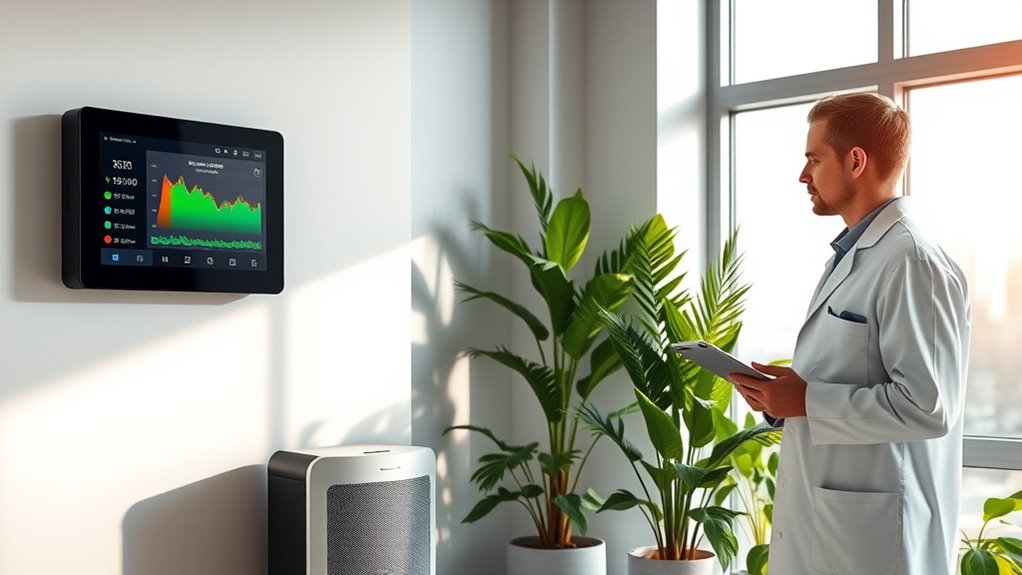
To keep your indoor environment healthy, you should regularly monitor your air quality to spot any issues early. Implementing effective ventilation strategies guarantees fresh air circulates and pollutants stay out. By combining these approaches, you create a safer, more comfortable space for everyone inside. Additionally, understanding aura colors and their meanings can help identify emotional and physical well-being, further contributing to a healthier environment.
Air Quality Monitoring
Ever wondered how you can guarantee the air inside your home stays safe and healthy? Monitoring your indoor air quality is key. By keeping track of pollutant levels, you can take immediate action before health issues arise. Here are four essential tools to help you stay informed:
- Air Quality Monitors – Continuous sensors that detect pollutants like VOCs, CO2, and particulate matter.
- Smart Devices – Apps and devices that provide real-time data and alerts on air quality changes.
- Humidity and Temperature Sensors – Ensuring ideal levels to prevent mold growth and maintain comfort.
- Periodic Testing Kits – More detailed analysis for allergens, bacteria, or chemical contaminants.
Using these tools, you can identify problems early, make informed decisions, and maintain a healthier indoor environment.
Effective Ventilation Strategies
Effective ventilation is vital for maintaining a healthy indoor environment because it guarantees a constant exchange of stale air with fresh outdoor air. Proper strategies guarantee pollutants, humidity, and odors are minimized, improving comfort and health. To maximize effectiveness, consider different ventilation types:
| Natural Ventilation | Mechanical Ventilation | Hybrid Systems |
|---|---|---|
| Uses windows and vents | Uses fans and HVAC | Combines both methods |
| Cost-effective but weather-dependent | Consistent airflow control | Flexible for various needs |
| Best for mild climates | Suitable for large or polluted areas | Offers balanced approach |
Choosing the right strategy depends on your space, climate, and budget. Proper maintenance of vents and regular filter changes also guarantee optimal air quality.
Long-Term Strategies for Sustaining Good Air Quality
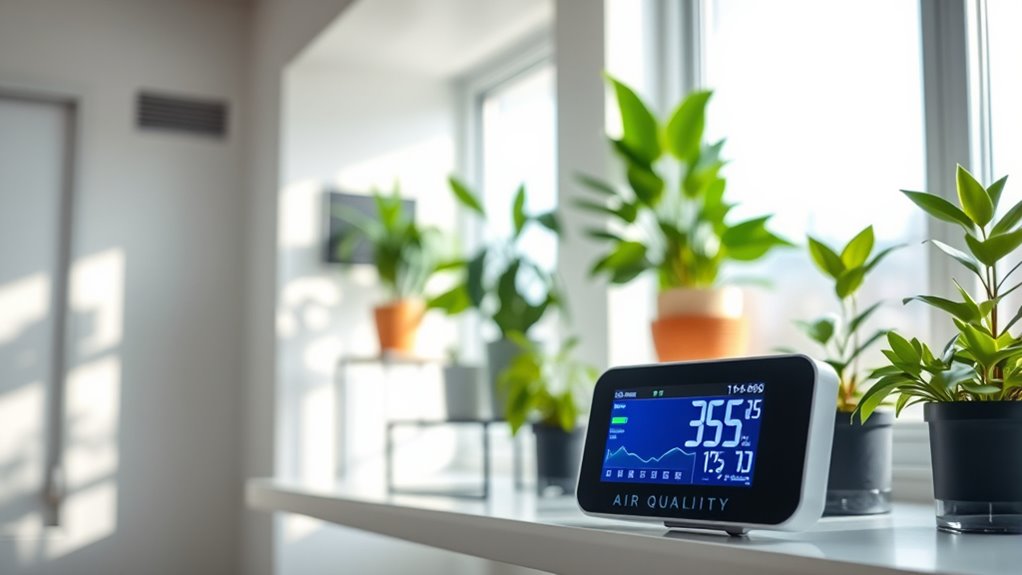
Maintaining good indoor air quality over the long term requires consistent effort and strategic planning. To keep your air clean and healthy, you should implement several key practices.
- Regularly schedule professional HVAC maintenance to ensure systems run efficiently.
- Use high-quality air purifiers in high-traffic or pollution-prone areas.
- Keep humidity levels between 30-50% to prevent mold growth.
- Avoid and promptly address sources of indoor pollution, like smoking or chemical cleaners.
Frequently Asked Questions
How Often Should Indoor Air Quality Be Tested?
You might wonder how often you should test your indoor air quality. Generally, it’s a good idea to check it at least once every few months, especially if you notice signs of poor air, like odors or allergies. If you have pets, smokers, or live in a new building, testing more frequently helps catch issues early. Regular testing guarantees your indoor environment stays healthy and comfortable.
Can Indoor Plants Improve Air Quality Effectively?
Sure, indoor plants might seem like nature’s air purifiers, but don’t rely on them alone. While they can absorb some toxins and boost humidity, their impact is often overstated. You’d need a jungle to see real benefits, and that’s not practical. Instead, combine plants with proper ventilation and air filters for a healthier space. Think of plants as a stylish bonus, not your primary solution.
Are There Health Risks From Low-Level Indoor Pollutants?
Low-level indoor pollutants can still pose health risks, especially over extended exposure. You might notice symptoms like headaches, allergies, or respiratory issues. Even at low levels, chemicals from cleaning products, paints, or building materials can accumulate and affect your health. It’s important to make certain of good ventilation, use low-emission products, and monitor indoor air quality to reduce these risks and create a healthier environment for you and your family.
What Are Cost-Effective Methods to Enhance Air Quality?
You wonder how to improve air quality affordably. Imagine a small office installing a portable air purifier, which substantially reduces pollutants without hefty costs. To enhance air quality cost-effectively, focus on proper ventilation—use exhaust fans and open windows when possible—and regularly maintain HVAC systems. These simple steps can make a noticeable difference, helping you breathe easier and create a healthier environment without breaking the bank.
How Do Seasonal Changes Affect Indoor Air Quality?
Seasonal changes substantially impact your indoor air quality. During winter, you might notice stuffiness and increased indoor pollutants because of closed windows and heating systems. In summer, higher humidity can lead to mold growth and dust mites. To keep your air healthy year-round, you should regularly ventilate, use dehumidifiers in humid months, and change filters frequently. Being aware of these seasonal shifts helps you take proactive steps to maintain better indoor air.
Conclusion
By understanding indoor air quality, measuring it accurately, and taking simple steps to improve it, you create a healthier, safer environment. You control the air you breathe, you enhance your well-being, and you safeguard your loved ones. You prioritize ventilation, you use effective filtration, and you maintain your space regularly. You commit to long-term strategies, you embrace ongoing care, and you guarantee your indoor air remains clean, fresh, and pure every day.
